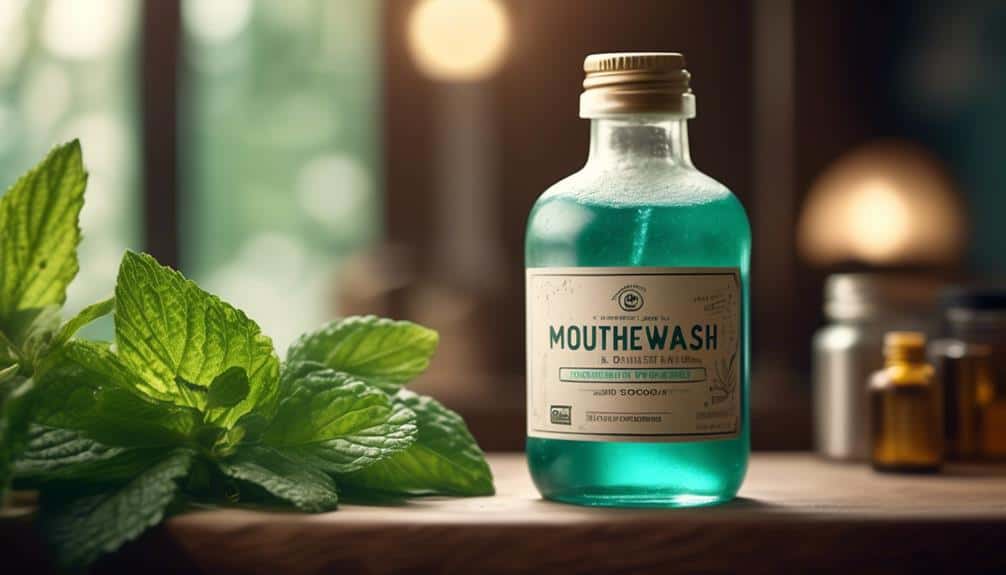As I stand here, gazing into a sea of plastic bottles and chemical-laden mouthwash options, I can't help but feel a pang of dissatisfaction. Surely there must be a better way to care for my oral health without harming the environment or subjecting myself to harmful ingredients.
Thankfully, I have discovered a remarkable solution that will not only revolutionize my oral care routine but also contribute to a more sustainable lifestyle. Intrigued? Well, let me introduce you to the world of DIY zero waste mouthwash, where simplicity, effectiveness, and eco-consciousness converge.
Key Takeaways
- Homemade mouthwash offers numerous benefits, including reducing waste and environmental impact by eliminating the need for single-use plastic bottles.
- By making your own mouthwash, you have the freedom to customize the ingredients to suit your personal preferences and oral health needs.
- Homemade mouthwash can save you money compared to store-bought options, while also providing a natural and chemical-free alternative.
- Proper storage is important for homemade mouthwash, including using glass containers, keeping it in a cool and dark place, and using it within a week to prevent bacterial growth.
Benefits of Homemade Mouthwash
Homemade mouthwash offers a range of benefits for both the environment and personal well-being. One of the key advantages is the oral health benefits of natural sweeteners used in homemade mouthwash. Natural sweeteners like xylitol not only provide a pleasant taste but also help to prevent tooth decay and promote oral health. Unlike store-bought mouthwash that often contains artificial sweeteners, homemade mouthwash allows for the use of natural and healthier alternatives.
Additionally, homemade mouthwash has a significantly lower environmental impact compared to store-bought options. Store-bought mouthwash typically comes in single-use plastic bottles that contribute to plastic waste and pollution. By making our own mouthwash, we eliminate the need for these bottles and reduce our carbon footprint. We can also choose to use sustainable packaging options, such as glass containers, further minimizing our environmental impact.
Ingredients for Homemade Mouthwash
When it comes to creating our own mouthwash, we've the freedom to select ingredients that align with our personal preferences and oral health needs. One important ingredient to consider is a natural sweetener, such as xylitol. Natural sweeteners not only add flavor but also provide oral health benefits. Xylitol, for example, has been shown to reduce the risk of tooth decay and inhibit the growth of bacteria in the mouth.
Another key ingredient is essential oils, which can be used to add flavor and freshen breath. Peppermint oil is a popular choice, but variations like spearmint or tea tree oil can also be used for variety.
Shelf Life and Storage of Homemade Mouthwash
To ensure the freshness and effectiveness of your homemade mouthwash, proper storage is essential.
Here are some tips for extending the shelf life of your homemade mouthwash and how to properly store it.
- Fresh aloe vera mouthwash typically lasts about 2 weeks in the fridge. To extend its shelf life, you can add aloe vera juice.
- Without preservatives, it's best to use homemade mouthwash within a week to prevent bacterial growth.
- Glass containers are recommended for storing homemade mouthwash, as they're non-reactive and maintain the freshness of the ingredients.
- It's important to keep the mouthwash in a cool and dark place to maintain its effectiveness.
Alternative Options for Homemade Mouthwash
For added convenience and variety, consider trying out different options when making your own mouthwash at home.
One alternative option is to experiment with using different natural sweeteners. Instead of using xylitol, you can try using other natural sweeteners like stevia or erythritol. These sweeteners not only provide a pleasant taste but also offer oral health benefits.
Another option to consider is using different essential oils. Peppermint is commonly used for its refreshing flavor, but you can also try spearmint or tea tree oil for a variety of flavors. Essential oils not only add flavor but also have antibacterial properties that can promote oral hygiene.
Where to Find Ingredients Zero Waste
For zero waste options, there are several places where you can find the ingredients for homemade mouthwash.
One option is to look for bulk bin options at health food stores or co-ops. These stores often have xylitol and baking soda available in bulk, allowing you to purchase only the amount you need and avoid unnecessary packaging.
Another option is to grow your own aloe vera plant. Aloe vera leaves can be harvested and used to extract the gel, providing a sustainable source of aloe vera for your mouthwash. If growing your own isn't feasible, some grocery stores may carry aloe vera leaves in the produce section.
Additionally, online zero waste stores or refill shops offer sustainable packaging options for ingredients like xylitol, baking soda, and essential oils.
Don't hesitate to ask local businesses or community groups for recommendations on where to find zero waste ingredients.
Conclusion
Say goodbye to store-bought mouthwash and hello to a sustainable and natural oral care routine! Homemade mouthwash not only reduces waste and environmental impact but also allows you to customize the ingredients to suit your needs.
With the power of xylitol, baking soda, aloe vera, and essential oils, you can revolutionize your oral health.
So, let's take the plunge into the world of DIY zero waste mouthwash and embark on a journey towards a healthier and greener future.




